The art of bowling in the sport of cricket is a complex one, but also an incredibly rewarding one. The first step that many cricketers take on the road to becoming a bowler is to understand the types of deliveries that it is possible for them to bowl. Trust me – I did that exact thing many years ago!
The 2005 Ashes series was my introduction to cricket, and I vividly remember listening to the great commentators of that era such as Richie Benaud and Tony Greig describe all of the different kinds of deliveries on display. I was immediately fascinated by Shane Warne’s slider, Flintoff’s reverse swinging balls and Glenn McGrath’s split finger delivery. It was around that time that I began my quest to understand all of the different types of deliveries and why bowlers would choose to use them. If you find yourself in a similar position right now to the one that I was in back then, I am sure that this blog post will be a great resource for you! If you continue reading, you’ll learn how many different types of cricket delivery there are, what they are called and what types of bowlers are responsible for bowling them. I’ll also give you a quick introduction on how to bowl them too! Let’s begin…
So, how many types of deliveries are there in cricket?
There are 25 main deliveries in the game of cricket. 14 of these are bowled by fast bowlers, who aim to beat batters with their pace and movement through the air or off the pitch. The other 11 are bowled by spin bowlers, who aim to outfox batters by varying their amount of spin, flight and speed, amongst other things.
Now that you know how many different types of deliveries there are, you’re probably asking yourself what each one is called! If you’d like to find out, take a look at the lists below…
The following deliveries are ones that are bowled by fast bowlers:
- Outswinger
- Inswinger
- Reverse swinging delivery
- The Bouncer
- The Yorker
- Cross Seam Delivery
- The Wobble ball
- Slower balls
- The Off Cutter
- The Leg Cutter
- Split Finger Delivery
- Back of the Hand Delivery
- The S.L.O.B (Slower Obsolete Ball)
- The Knuckle ball
- The Palm Delivery
The following deliveries are ones that are bowled by spin bowlers:
- The Leg Break
- The Googly
- Top spinner (Leg Break Bowlers)
- The Slider
- The Flipper
- The Off Break
- Top spinner (Off Break Bowlers)
- The Arm Ball
- The Doosra
- The Carrom Ball
- Under Cutter
There are also the following two deliveries which don’t really fit into either category – but I’ll cover them in this post anyway:
- The Full Toss
- The Beamer
I’ll now explain each of the deliveries I’ve mentioned above in a bit more detail, telling you how each one behaves and giving you a brief explanation of how you can bowl it! Enjoy!
Fast Bowling Deliveries
Outswinger
An outswinger is a delivery where the ball ‘swings’ through the air. This means that once the bowler releases the ball, it does not travel straight towards the batter at the other end of the pitch. Instead, the flight path of the ball is slightly curved. For right arm bowlers, an outswinger will swing from right to left – away from a right handed batter. For left arm bowlers an outswinger will swing from left to right – away from a left handed batter. Have a look at the diagram below if you want to see what I mean!
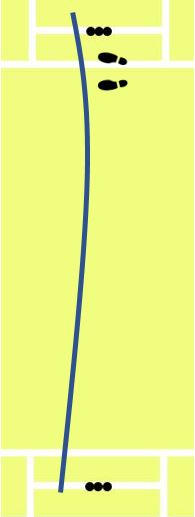
When bowling the outswinger, a bowler will be trying to land the ball on a good/full length just outside the off stump. The goal is to tempt the batter into playing an expansive drive whilst the ball is moving away from them in the air. If the batter misjudges their shot slightly, there is a high chance they could get an outside edge on the ball and nick it through to the keeper or the slip fielders. This is an incredibly common mode of dismissal in cricket.
So, how does the outswinger work? At a very basic level, it comes down to the condition of the ball and the way the bowler grips and releases it from their hand. I have a much more detailed guide on bowling outswingers that you can read by clicking here, but if you’re looking for a quick guide to bowling the delivery, have a read through the steps below:
- Make sure the ball is in good condition for swing bowling. If you have a new cricket ball, or one where one side of the ball is shiny and one side is dull and scuffed up, this will be perfect.
- Hold the ball in your hand like I’m demonstrating in the pictures below. Rather than having your fingers parallel with the seam as you would when bowling normally, the ball should be turned slightly so that the seam points towards first slip. For right arm bowlers, the dull/scuffed side of the ball should be on the left. For left arm bowlers, the dull/scuffed side of the ball should be on the right. The ball should swing in the direction of the dull/scuffed up side.
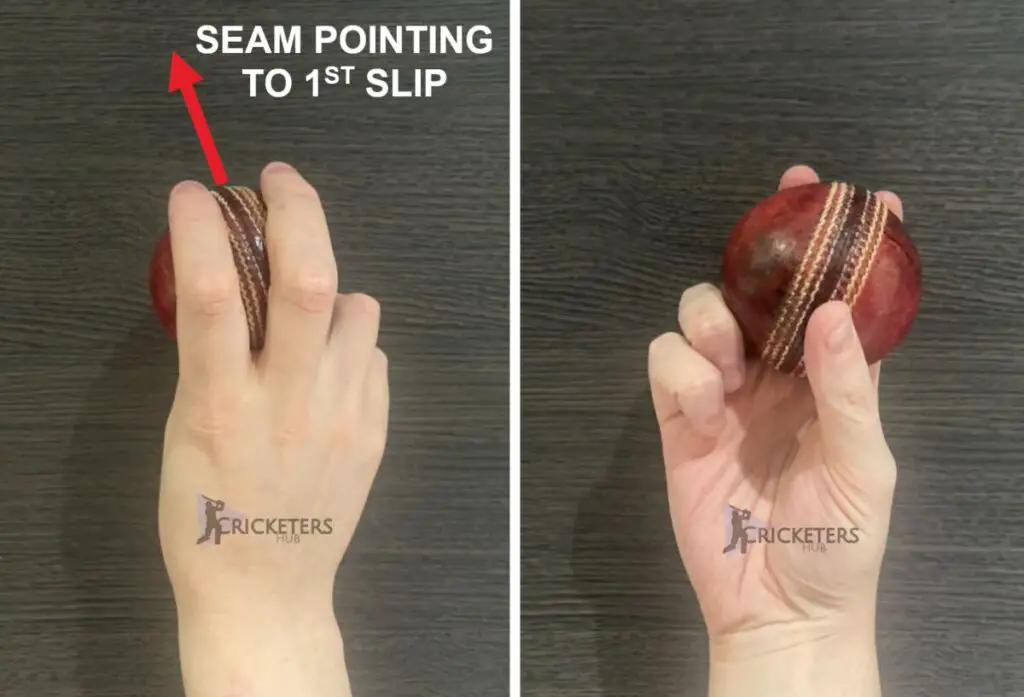
- Run up and bowl as normal. As the ball leaves your hand, try to make sure that the last finger to make contact with the ball is your index finger. Doing this helps to ensure that the seam points in the required direction as it travels through the air and makes the ball much more likely to swing.
If you want to see this kind of delivery being bowled, I’d recommend watching plenty of clips of bowlers like Jimmy Anderson, Dale Steyn and Mitchell Starc. The outswinger has been a great weapon over the years for all 3 of those guys!
Inswinger
As you may have already guessed, an inswinger is essentially the opposite of an outswinger! This means that for right arm bowlers, an inswinger will swing from left to right – or in towards the body of a right handed batter. For left arm fast bowlers, an inswinger will swing right to left, or in towards the body and the stumps of a left handed batter. The diagram below should explain this a little better.
When bowling an inswinger, a fast bowler may choose to target the stumps or the pads of the batter. This works particularly well if the inswinger is used as a surprise ball! For example, Jimmy Anderson will regularly bowl a few overs of outswingers to certain players, and then bowl the inswinger as a surprise delivery targeting the pads. Because the batter has gotten used to playing the ball moving away from them, they can easily end up missing the straight one and getting out bowled or LBW. The inswinger can also be bowled on a line outside the off stump. The batter will then have to judge exactly how much the ball will swing in order to defend or attack the ball confidently. This can lead to outside/inside edges.
Once again, bowling the inswinger is largely dependent on the condition of the ball, how the bowler grips it and how they release it from their hand. If you want a basic guide on how to do this, take a look at the steps below!
- Make sure the ball is in an appropriate condition for swing bowling. It should ideally be a brand new ball, or a ball that has been shined on one side, with the other side being allowed to deteriorate and get scuffed up.
- Hold the ball in your hand like I’m demonstrating in the pictures below. Rather than having your fingers parallel with the seam as you would when bowling normally, the ball should be turned slightly so that the seam points towards leg slip or fine leg. For right arm bowlers, the dull/scuffed side of the ball should be on the right. For left arm bowlers, the dull/scuffed side of the ball should be on the right. The ball will swing in the direction of the scuffed up side.
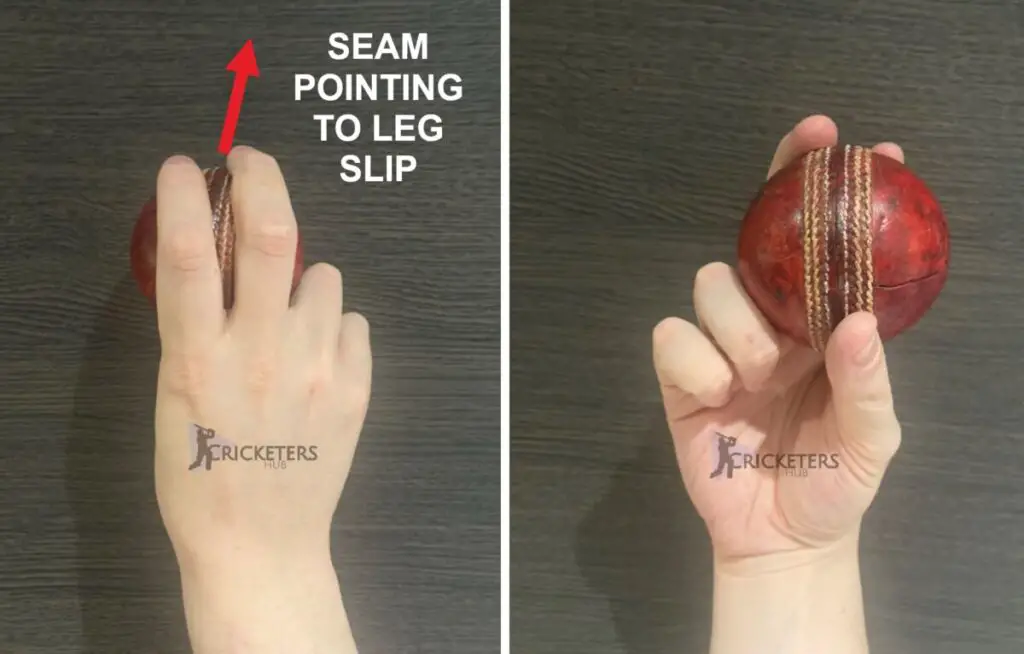
- Run up and bowl as normal. As the ball leaves your hand, try to make sure that the last finger to make contact with the ball is your middle finger. Doing this helps to ensure that the seam points in the required direction as it travels through the air and makes the ball much more likely to swing.
If you want some inswinging inspiration, find some videos of bowlers like Waqar Younis and Bhuvneshwar Kumar. They are two of my favourite exponents of the inswinging delivery!
Reverse Swinging Delivery
Reverse swing is a concept that confuses many cricket fans and players. It is much harder to get a cricket ball to reverse swing than it is to bowl conventional outswing or inswing like I explained above.
So, what’s the difference between reverse swing and conventional inswing/outswing? The main difference is that when bowling reverse swing, the ball will always swing in the direction of the shiny side of the ball. When bowling normal outswing/inswing, the ball will swing towards the dull/scuffed up side. The second difference is that reverse swing can only be bowled with an old ball that has been allowed to undergo significant deterioration. It isn’t possible to get a new ball to reverse swing! One of the other main differences is that reverse swing is only really possible to bowl if you’re a quick bowler. Bowlers that bowl less than 80mph will struggle to achieve reverse swing! If you’re interested in learning more about the art of reverse swing bowling, click here to read my full in-depth guide on it!
Reverse swing is considered to be a lot more dangerous than conventional swing because it occurs much later in the flight of the ball. When a ball swings early, a batter can spot this much quicker. This gives them more time to react and play an appropriate shot. Because reverse swing generally happens later, it is much harder for a batter to react to.
To have a go at bowl reverse swing, follow these steps:
- Ensure you’re quick enough for this type of bowling. If you can bowl above 80mph you’ve got a pretty good chance of achieving it!
- Make sure the ball is in the correct condition for reverse swing bowling. You’ll probably need to have a ball that is in excess of 40 overs old which has been shined thoroughly on one side. The other side will need to have deteriorated significantly.
- Hold the ball in the conventional fast bowling grip, shown below. Your fingers should be running parallel to the seam.
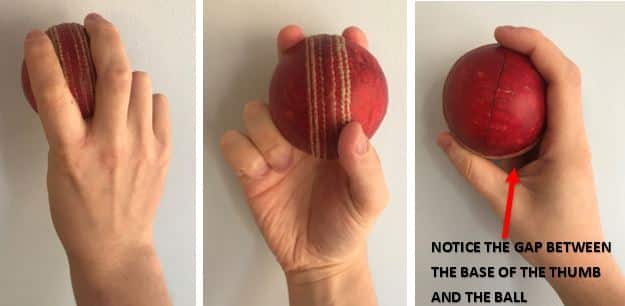
- If you want the ball to swing to the right (in towards a right handed batter), place the shiny side of the ball on the right side of your hand. If you want the ball to swing to the left (in towards a left hander), place the shiny side of the ball in the left side of your hand.
- Run up and bowl fast, as normal. Try to ensure that the seam stays upright as the ball travels through the air. This will give the ball the best chance to swing.
If you would like to see great reverse swing bowling in action, I’d recommend watching some of Andrew Flintoff and Simon Jones’ wickets from the 2005 Ashes. That was probably the best display of reverse swing bowling that I’ve ever seen live! Some of Jasprit Bumrah’s spells in England in 2021 were pretty good too!
The Bouncer
The bouncer is one of a fast bowler’s deadliest weapons. If you’re not sure what it is, it is basically a hostile delivery that the bowler will aim to land around halfway down the cricket pitch. When the cricket ball lands in this area, the ball will end up bouncing high by the time it reaches the batter. Ideally, the ball will be somewhere between shoulder and head height by the time it gets to them. As for the line of the ball, the bowler should always be targeting the batter’s body when bowling the bouncer. If it is bowled wide of the off stump or down the leg side it becomes easy for the batter to evade.
If this type of delivery is bowled quickly and accurately, it can be very intimidating – which is exactly what a fast bowler should be aiming for when choosing to bowl it! It may end up striking the batsman on the body or forcing them into evasive action. Both of these are a win for the bowler. In my opinion, the main advantage of a well-executed bouncer is that it will push the batter on to the back foot and make them reluctant to come forwards. This can make any full deliveries that you bowl afterwards extra deadly because the batsman may not be moving their feet forwards as fluently!
Bowling a bouncer may seem simple – but I can assure you that there is an art to bowling good ones! If you’d like to learn more about what it takes to bowl threatening bouncers, click here to read my detailed guide on that. If you’re looking for inspiration, you should probably watch this video. This was one of the most brutal, hostile pieces of fast bowling I’ve ever seen, and as you can see, it even made a player of the calibre of Steve Smith second guess himself.
Obviously, the goal of the bouncer isn’t to physically harm someone – and that should never really be celebrated. Especially when a batter sustains an injury! However, it is intended to intimidate them and force them outside of their comfort zone.
The Yorker
The yorker is probably my favourite fast bowling delivery! If you’ve never heard of it before, then you’ve been missing out!
A yorker is a delivery that pitches on an extremely full length, usually somewhere around the batsman’s feet or the popping crease. My diagram below should explain this if you’re having trouble visualising it!
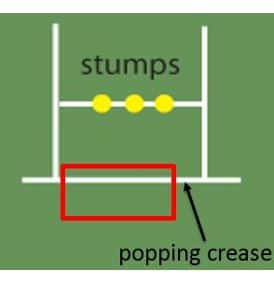
The task when bowling a yorker is getting the ball to bounce at the exact moment that it reaches the batter. This is an incredibly fine margin of error, but if a bowler can achieve this, the yorker becomes one of the hardest deliveries for a batter to play. If a yorker is bowled at high pace and the bowler can get it to swing, it becomes even more dangerous. These types of deliveries can easily sneak under the bat and smash in to the wickets or the batter’s pads.
You definitely see the yorker used more frequently in T20 and 50 over cricket than in test cricket, and this is probably because batters are more likely to be in attacking mode in those formats and the yorker is the hardest delivery to score runs off. A batter who is aiming to get underneath the ball and hit it for 6 will find it almost impossible if the bowler delivers an accurate yorker. In a test match, a batter can simply play defensively and block the ball without the pressure to score runs. However, that does not mean that the yorker isn’t an effective ball in long form cricket! Trust me, it works in all formats!
I put together a helpful guide on how to bowl more accurate yorkers which you can read by clicking here. My favourite yorker bowlers in world cricket in the last few years have been guys like Lasith Malinga and Jasprit Bumrah. So if you want a masterclass in how to bowl them, I’d recommend watching some clips of those two!
Cross Seam Delivery
A cross seam delivery is a ball that surprisingly few fast bowlers know about, but in my opinion it’s definitely one that should be used more frequently!
A cross seam delivery is a type of variation that a fast bowler will use in order to attempt to make the ball bounce in an unusual way on pitches that aren’t naturally that helpful to their style of bowling. Instead of gripping the ball with the seam running parallel to the fingers as they would when bowling a normal delivery, a fast bowler will turn the ball around in their hands so that the seam is running across the fingers. You can see me demonstrating this in the photo below.
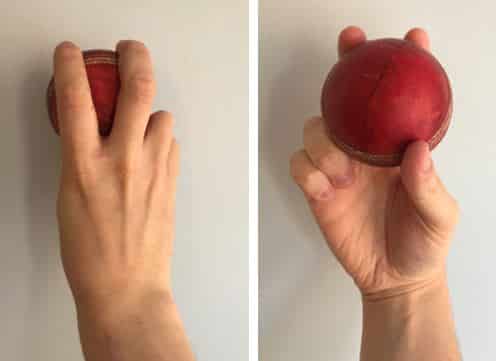
Once the ball is in this position, all the fast bowler needs to do is run up and bowl the ball as they usually would. It’s that simple!
The cross seam delivery is effective because it can extract up and down seam movement from the surface when the pitch is pretty unresponsive. Basically, if the bowler can get the polished, leather side of the ball to land on the pitch as shown in the diagram below, the ball may skid on towards the batter and bounce lower than usual.
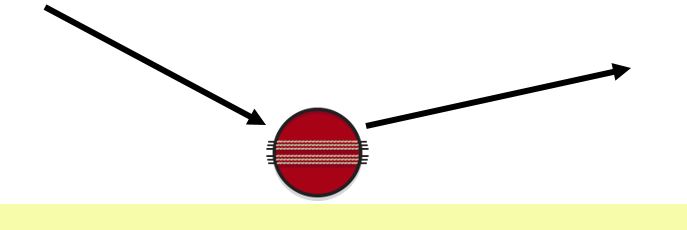
Conversely, if the bowler can get the seam of the ball to dig into the surface like you can see in the diagram below, the ball may get ‘stuck in the pitch’, leading it to slow down and maybe bounce a little higher than normal.
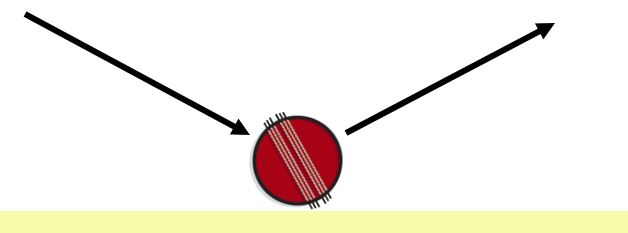
If you’d like to read more on cross seam deliveries – click here to view my full post on them!
Wobble Ball
The wobble ball is a delivery that has steadily rose to prominence in test cricket in the last 15 years due to fast bowlers like Mohammad Asif, Jimmy Anderson & Stuart Broad. Basically, it is a delivery that a bowler will use when the ball isn’t swinging and when the pitch isn’t offering much movement. The wobble ball helps the ball to seam around, and although the bowler doesn’t know exactly how the ball will behave – neither does the batter!
At this point you may be wondering how exactly a certain type of delivery can help the ball to seam around once it hits the pitch. It’s actually much simpler than you may think! Basically, a wobble ball causes the seam to ‘wobble’ from side to side as the ball travels through the air. This means there is a larger chance that the ball will land with half of the leather side and half of the seam touching the pitch at the same time, as shown in the diagram below! If the ball lands like this, it makes seam movement much more likely.
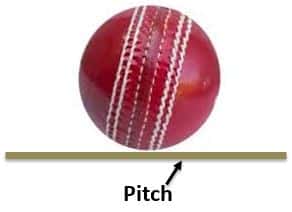
So, how do you bowl the wobble ball? Certain bowlers bowl it differently, but in my opinion the best and most reliable way is as follows:
- Hold the ball in the grip that is usually used for the outswinger – shown in the picture below. As you should know if you’ve read the rest of this post, the seam should be turned so that it points towards the slips
- Widen your index and your middle finger slightly, ensuring that there is a larger gap between them than there was originally.
- Run up and bowl the ball in the same way that you would bowl a normal fast bowling delivery. When bowling the outswinger, you would try to ensure that the last finger that touched the ball was your index finger, however, when bowling the wobble ball, you need to drag both your index and middle fingers down the back of the ball at the same time. This ensures that the seam wobbles from side to side as it travels through the air, rather than remaining upright as it should when bowling outswing/inswing!
The photo below shows Jimmy Anderson’s hand position as he releases the wobble ball. You can see that his middle and index fingers are angled across the seam – which is the grip required for the outswing delivery. However, his fingers are wider than he usually has them! This is the key to bowling the wobble ball. Get this right and you’ll nail it!
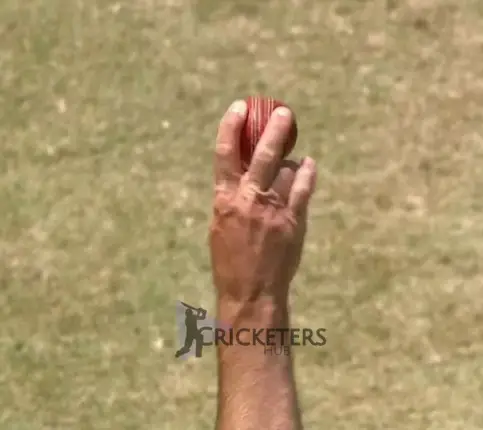
Off Cutter
An off cutter is one of the many slower balls that it is possible for a fast bowler to deliver. Slower balls often confuse batters because they usually get comfortable with playing their shot very quickly against a fast bowler’s quicker deliveries. So, when they receive a slower one, they often complete their shot too early. This can lead to them hitting the ball straight up in the air or tamely in the direction of a fielder, and it can also lead to them missing the ball entirely!
There are many different ways of bowling slower balls, so what makes the off cutter unique? Well, to bowl the off cutter, the fast bowler must use a slightly different grip and roll their fingers down one side of the ball as it leaves their hand. Because the fingers are spinning the ball as it leaves the hand rather than propelling the ball forwards, the delivery comes out a lot slower. Here are my basic steps for bowling it:
- Stand at the end of your run up and prepare to run up and bowl like you normally would
- Position the ball in your hand exactly like I’m showing in the picture below. Your index finger should be close to the seam, but your middle finger should be moved down so it sits on the side of the ball
- Go through your bowling action as normal, but as you are in the process of releasing the ball, rotate your hand slightly and drag your index finger down the side of the ball. Right arm bowlers should be dragging their index finger down the right side of the ball, and left arm bowlers should be dragging theirs down the left side. This rotation applies the spin to the ball and will lead to it coming out of your hand naturally slower
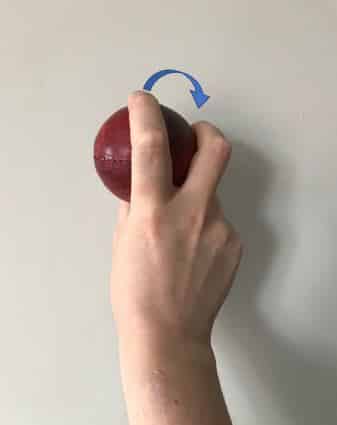
If you want a more detailed guide on how to bowl the off cutter, including different ways to practice it and my thoughts on the exact situations when you should bowl it – click here!
Leg Cutter
A leg cutter is also one of the slower balls that is available to a fast bowler, and as you may have guessed – it’s essentially the opposite of an off cutter. The leg cutter requires a slightly different grip, and also requires the bowler to spin the ball in the opposite direction! Personally, I always found the leg cutter harder to bowl than the off cutter, but I also know many bowlers that prefer this one! Follow these steps if you want to bowl it:
- Stand at the end of your run up and prepare to run up and bowl like you normally would
- Position the ball in your hand exactly like I’m showing in the picture below. With the leg cutter, your middle finger should be close to the seam, with your index finger moved slightly down the side of the ball.
- Go through your bowling action as normal, but as you are in the process of releasing the ball, rotate your hand slightly and drag your middle finger down the side of the ball. Right arm bowlers should be dragging their middle finger down the left side of the ball, and left arm bowlers should be dragging theirs down the right side. When you do this, it applies a bit of spin to the ball and allows it to slip out of the side of your hand. Because your fingers aren’t behind the ball propelling it forwards, this delivery will come out of your hand a lot slower than your stock ball.
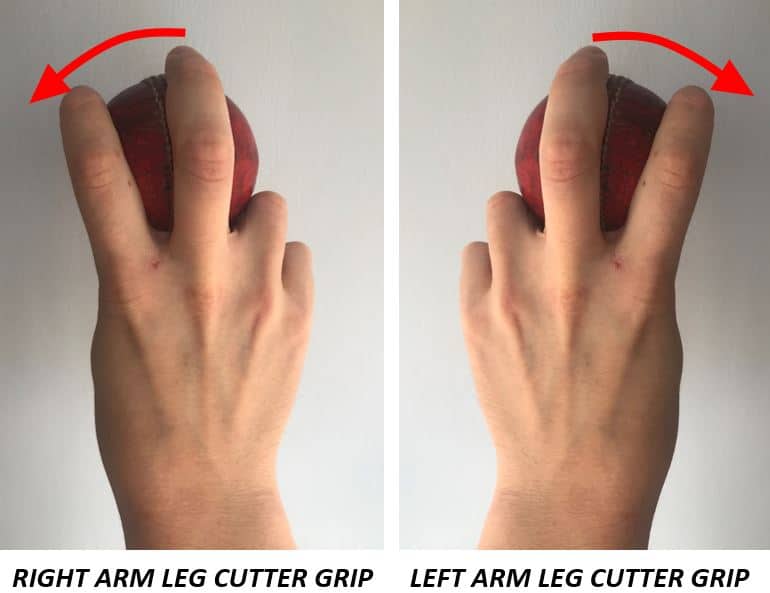
I’ve also written a comprehensive guide to bowling the leg cutter accurately and effectively – so if that sounds like something you’d be interested in having a look at then make sure you click here!
Split Finger Delivery
The split finger delivery is another incredibly simple slower ball that is available for fast bowlers to use. As I said at the start of this post, the first bowler that I remember seeing using this ball was the Australian legend Glenn McGrath, and I immediately started practicing it myself in my back garden!
If you want to learn how to bowl the split finger ball, follow the steps below:
- Hold the ball in the correct grip, which I’m demonstrating in the photo below! In the normal fast bowling grip, the fingers are placed either side of the seam but quite close together. With the split finger ball, you must spread them wider. It is important to place the fingers wide, but not too wide that it becomes uncomfortable.
- Approach the crease as exactly as you usually would, with the same run up and delivery stride.
- As your arm comes over and you release the ball, keep your wrist upright and try to bowl the ball as normally as possible. Because you have your index and middle fingers spread a lot wider apart, you have less force behind the ball. Also, the gap in between your fingers allows the ball to escape through the gap and float out a lot slower!
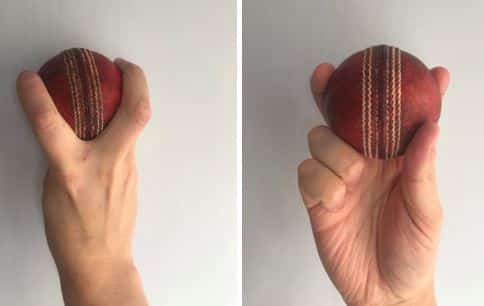
Back of the Hand Ball
The back of the hand delivery is another type of slower ball that you’ll see used quite regularly in professional cricket. In my opinion it’s one of the hardest deliveries to master because it requires the bowler to release the ball in a completely different way from the one that they are used to. If you want to start bowling this delivery accurately in an actual cricket match, you’ll have to put a heck of a lot of time into practicing it in the nets beforehand! Let’s have a look at how to bowl it:
- Hold the ball with your normal fast bowling grip and stand at the end of your run up, preparing to approach the crease.
- Go through your run up and your bowling action exactly as normal. The only thing that needs to change for this delivery is your release!
- As your bowling arm rotates around and you prepare to release the ball, you must you’re your arm around so that the back of your hand is facing the batter. You can see me demonstrating this in the photo below. Usually when you release the ball the batter will be able to see the palm of your hand, so the batter will have to pick up this subtle change if they want to know that the ball is coming.
- As the ball is about to leave your hand, flick your hand forwards slightly so that the ball pops out of the back of it.
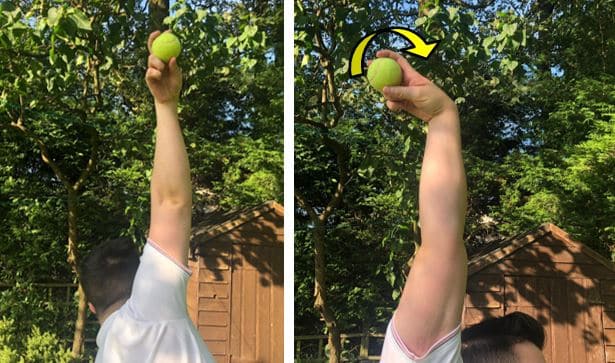
Bowlers who I remember bowling a lot of these types of balls are James Faulkner, Tymal Mills and Jade Dernbach. I’ve watched Tymal Mills in particular bowl this delivery a lot in recent years and he bowls it so well that he can get the seam to remain upright as it travels through the air. This means that sometimes he even gets this ball to swing – making it even more deadly!
The S.L.O.B (Slower Obsolete Ball)
The S.L.O.B is another pretty simple slower ball. You don’t have to change much about your bowling style or grip to be able to bowl it – but there are a lot of fast bowlers who find it hard to control and bowl accurately. The only thing you need to adjust is your grip just prior to releasing the ball. Allow me to explain it in a bit more detail:
- Hold the ball in your usual fast bowling grip, with your index and middle fingers running parallel to the seam.
- Approach the crease as exactly as you usually would, with the same run up and delivery stride.
- As your bowling arm comes over and you prepare to bowl, lift your thumb off the side of the ball. Once you do this, your grip should look like mine in my picture below!
- Now your thumb is removed from the ball, release it using your index and middle fingers to guide it in the flight. Believe it or not, simply taking your thumb off the ball makes the delivery come out a lot slower, and this is a delivery that it’s very hard for the batter to spot!
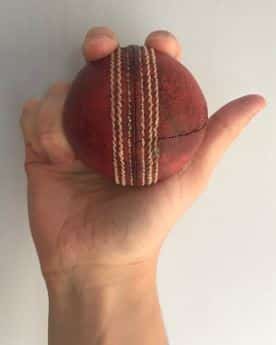
The S.L.O.B is a slower ball that I haven’t seen professional bowlers use that much, but it’s definitely an effective one. Why not give it a try in the nets and see if it works for you?
Knuckle Ball
The knuckle ball is an incredibly effective slower ball that plenty of professional fast bowlers use. I remember watching Jofra Archer use this quite a few times and it completely flummoxed many batters. I’m not sure why it’s so effective, but it always seems to float towards the batter and then dip at the last second – making it very hard for them to play. Let’s take a quick look at how to bowl it:
- Hold the ball in the correct grip, which I’m demonstrating in the photo below. This delivery requires you to place the surface of your fingernails flat against the surface of the ball, which takes away your ability to grip the ball very hard.
- Approach the crease as exactly as you usually would, with the same run up and delivery stride.
- As your arm rotates, release the ball off your knuckles. Because your grip on the ball is a lot weaker than usual, you will feel it leave your hand in a lot ‘looser’ fashion. It is this that creates the difference in pace.
It’s always worth mentioning that the grip I showed in the picture above will be a very difficult way to hold the ball as you approach the crease. Especially for younger bowlers or bowlers that have smaller hands/fingers. To combat this, you may want to consider approaching the crease whilst holding the ball in a normal fast bowling grip, then switching to the knuckle ball grip just as your arm begins to rotate in order to release the ball. This takes quite a bit of practice to get right – so I’d recommend working on it for a long time in the nets before taking it into a game!
The Palm Delivery
I wasn’t really aware of this ball until recently when I heard Stuart Broad talking about it in an interview – but if he’s a fan of it then there’s no reason why I shouldn’t share it here!
Basically, the palm delivery (that’s the name I chose to give it) is another type of slower ball that is completely reliant on how the fast bowler grips the ball. Allow me to explain it below:
- The key to this ball is holding it in the correct grip. Instead of having a nice gap between the palm of the hand and the surface of the ball like you would when using the normal fast bowling grip, the bowler should force the ball back into the palm of their hand like I’m showing in the picture below. This means that your fingers have less control over the ball, so they can’t propel it forwards as forcefully.
- Approach the crease using your normal run up and delivery stride.
- Release the ball exactly as you usually would. Due to the fact that the ball is more firmly pressed into the palm of your hand, it won’t leave your hand with as much zip and speed as it usually would.
Spin Bowling Deliveries
The Leg Break
The leg break is the first spinning delivery that we’re going to cover in this post. It is the stock delivery that is bowled by leg spin (or wrist spin) bowlers, so if you’ve ever watched a bowler like Shane Warne, Adil Rashid or Yuzvendra Chahal bowl, this is the delivery they were probably bowling most of the time!
So, how does the leg break behave? For right arm leg spin bowlers the leg break will pitch and spin from right to left. For left arm leg spin bowlers the leg break will spin from left to the right. When bowling this delivery, the bowler should be aiming to land the ball on a good/full length and tempt the batter to try to drive the ball. This gives the bowler the best chance of getting a wicket.
To bowl this delivery, the bowler needs to flick their wrist before rotating their fingers over the top of the ball. Let me give you a more detailed run down below:
- The first thing to get right is the grip, and you can see this in my picture below.
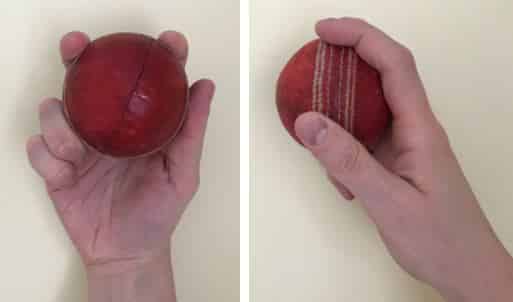
- With the ball gripped properly, the spin bowler should begin their run up and prepare to deliver the ball once they reach the crease.
- As the bowling arm rotates and gets to its highest point, the bowler must ensure that their palm is pointing in a specific direction. This helps to make sure that the spin will be applied in the right direction. Right arm leg spin bowlers should be pointing their palm in a north east direction, or towards the number 1/2 if you imagine a clock face. Left arm leg spin bowlers should do the opposite, pointing their palm in a north west direction, or in the direction of the numbers 10/11 on an imaginary clock face. The photos below should make this a bit clearer!
- Finally, the bowler must now apply the spin as they release the ball. The wrist should be flicked inwards, allowing the middle finger and the ring finger to rotate over the top of the ball as forcefully as possible. The more force applied, the more aggressively the ball will spin. Take a look at the diagram below to see what I mean!
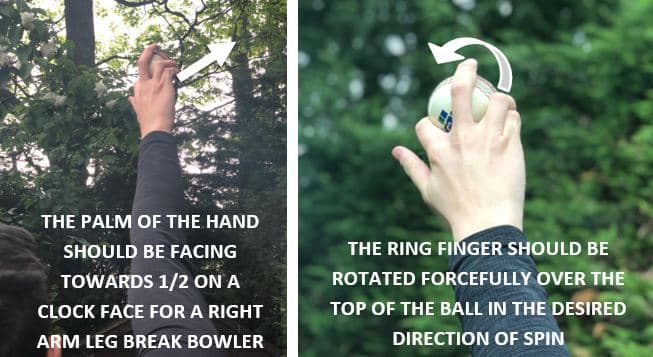
If you’d like to read a more in depth guide about how to bowl the leg break, including more details about the grip, the bowling style and the tactics involved in bowling it – click the link here!
The Googly
The googly is the most famous ‘variation’ delivery that is bowled by leg spin bowlers. It spins the opposite way to a leg break, which confuses a lot of batters who assume the bowler is going to bowl leg breaks. If the batter doesn’t pick up the change in the bowler’s action as the ball is released from their hand, there is a high chance they will end up playing a false shot against the googly and getting dismissed as a result. In world cricket today, Adil Rashid, Adam Zampa and Shadab Khan all have excellent googlies, so watch out for these the next time you see them play!
So, how does the leg spin bowler bowl the googly? It all comes down to the position of their arm/hand as they release the ball. Let’s take a closer look:
- Hold the ball in the normal leg break grip that I’m demonstrating below.

- With the ball gripped properly, the spin bowler should begin their run up and prepare to deliver the ball once they reach the crease.
- As the bowling arm rotates and gets to its highest point, the bowler must ensure that their palm is pointing in a specific direction. This helps to make sure that the spin will be applied in the right direction. Right arm leg spin bowlers should twist their arm around so that their palm is pointing in a south east direction, or towards the number 4/5 if you imagine a clock face. The back of the hand should be facing the batter. Left arm off spin bowlers should do the opposite, pointing their palm in a south west direction, or in the direction of the numbers 7/8 on an imaginary clock face. Again, the back of the hand should be facing towards the batter. The photos below should make this a bit clearer!
- Finally, the bowler must now apply the spin as they release the ball. The middle finger and the ring finger should rotate over the top of the ball as forcefully as possible.
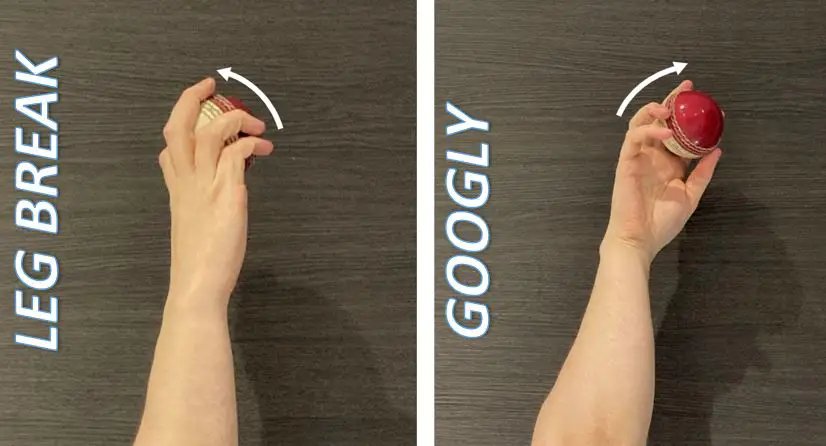
Because so many leg spin bowlers want to know how to bowl a perfect googly, I thought I’d write a longer post describing all of the specifics. This was just the short version! If you want the longer one, click the link here and dive in!
Top Spinner (Leg Spin Bowlers)
The top spinner is another variation delivery that is available to leg spin bowlers. The goal with a top spin delivery is to make the ball spin straight on towards the batter. So, if the batter was expecting the ball to spin away from them or in towards them, a delivery like the top spinner that goes straight on could take them by surprise. The added benefit of the top spinner is that it can dip on the batter suddenly during the flight, and it can also bounce a lot more than usual due to the overspin that is put on the ball. It’s a deadly delivery for spinners to have in their armoury, and it’s particularly dangerous on hard, bouncy pitches. Let’s look at how leg spin bowlers bowl it:
- Hold the ball in the normal leg break grip that I’m demonstrating below.

- With the ball gripped properly, the spin bowler should begin their run up and prepare to deliver the ball once they reach the crease.
- As the bowling arm rotates and gets to its highest point, the bowler must ensure that their palm is pointing in a specific direction. This helps to make sure that the spin will be applied in the right direction. Right arm leg spin bowlers should twist their arm around so that their palm is pointing towards the east, or towards the number 3 if you imagine a clock face. The thumb-side of your hand should be pointing directly towards the batter as you deliver the ball. Left arm leg spin bowlers should do the opposite, pointing their palm towards the west, or in the direction of the number 9 on an imaginary clock face. Again, the thumb-side of the hand should be facing towards the batter. The photos below should make this a bit clearer!
- Finally, the bowler must now apply the spin as they release the ball. The middle finger and the ring finger should go directly over the top of the ball – applying the over spin.
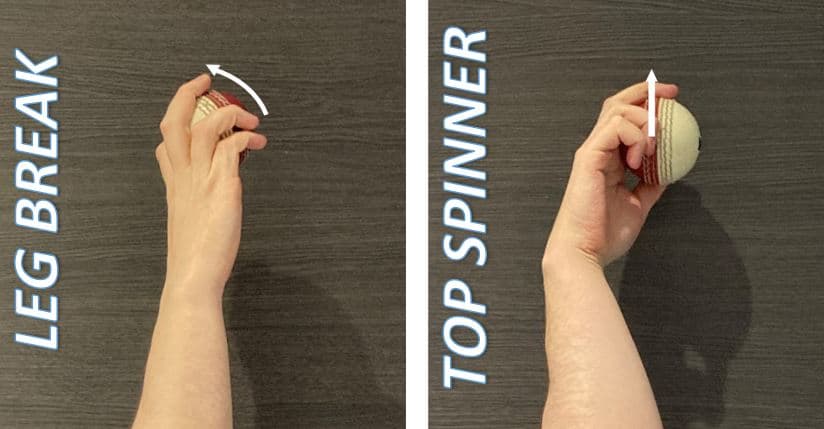
The Slider
The slider is another popular variation that is bowled by leg spin bowlers. This ball looks identical to a normal leg break, except instead of spinning once it hits the pitch, it ‘slides’ straight on towards the batter. I remember Shane Warne using this ball to great effect, especially in the 2005 Ashes. He would regularly set batsmen like Ian Bell up by bowling a series of huge turning leg breaks and moving the batsman across the crease, before following it up with the slider to trap them LBW. He really was a master of his craft!
The slider really can be a deadly delivery if you can get it right. Let’s see what it takes below:
- Hold the ball in the normal leg break grip that I’m demonstrating below.

- With the ball gripped properly, the spin bowler should begin their run up and prepare to deliver the ball once they reach the crease.
- As the bowling arm rotates and gets to its highest point, the bowler must ensure that their palm is pointing in a specific direction. This helps to make sure that the spin will be applied in the right direction. For both right arm and left arm leg break bowlers, the palm of the hand should be pointing directly towards the batter as the ball leaves the hand. The photos below should make this a bit clearer!
- Finally, the bowler must now apply the spin as they release the ball. The middle finger and the ring finger should rotate over the top of the ball as forcefully as possible, causing the ball to rotate as it travels through the air. Because the palm of the hand is facing directly towards the batter at release, this ensures that only side spin is being applied to the ball. More often than not, side spin will lead to the ball skidding on towards the batter.
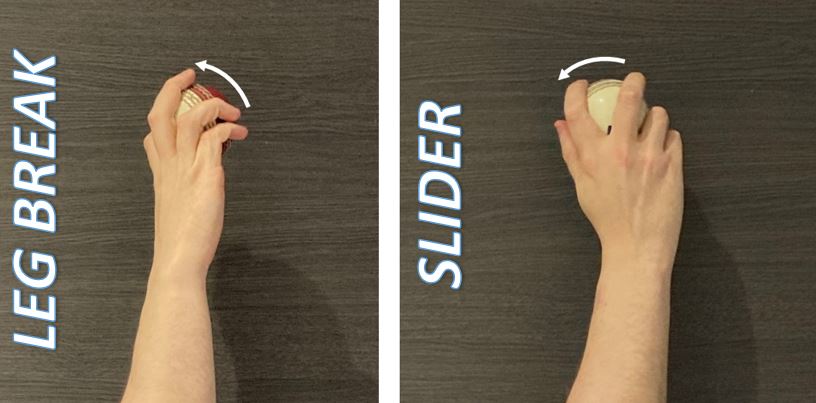
If a bowler wants to ensure that the ball goes straight on once it hits the pitch, they can twist their arm around a little further than I spoke about above. For right arm leg spin bowlers, this would mean pointing their palm in a north west direction, or towards the number 11 on an imaginary clock face. For left arm leg spin bowlers, they should point their palm in a north east direction, or towards the number 1 on an imaginary clock face.
The Flipper
The flipper is the final variation that I’m going to cover for leg spin bowlers. It’s probably the most difficult leg spin variation to bowl, and the most difficult one to explain! Even the legendary Shane Warne took a long time to master this ball, so be aware that you’ll have to put an incredible amount of practice time in if you want to be able to bowl it accurately and reliably during real game situations.
The flipper uses the same grip as all the other leg spin variations, but it has a completely different method of release – something that not a lot of spinners will be comfortable with. However, if you can get it right, it’s very rewarding. It comes out a lot faster than some other spinning deliveries and will shoot low straight towards the batter on a different trajectory. Let’s have a look at how to bowl it below:
- Hold the ball in the normal leg break grip that I’m demonstrating below. However, this time you may choose to hold it slightly more with your fingertips, rather than allowing it to rest in your palm as much.

- With the ball gripped properly, the spin bowler should begin their run up and prepare to deliver the ball once they reach the crease.
- As the bowling arm rotates and gets to its highest point, the leg spin bowler must position their hand as they would when bowling a top spinner. Right arm leg spin bowlers should point their palm eastwards, and left arm bowlers should point their palm westwards. In both cases, the thumb-side of the bowling hand should be pointed directly towards the batter
- As the ball is about to be released, squeeze your thumb towards your index and middle fingers. Your thumb should push backwards over the top of the ball, while your index and middle fingers squeeze downwards on the bottom part of the ball. Imagine you were clicking your fingers – the motion that is required to bowl the flipper is almost exactly the same as this!
- The motion that I’ve just described should cause the ball to shoot out of the front of your hand with plenty of backspin being applied to the ball.
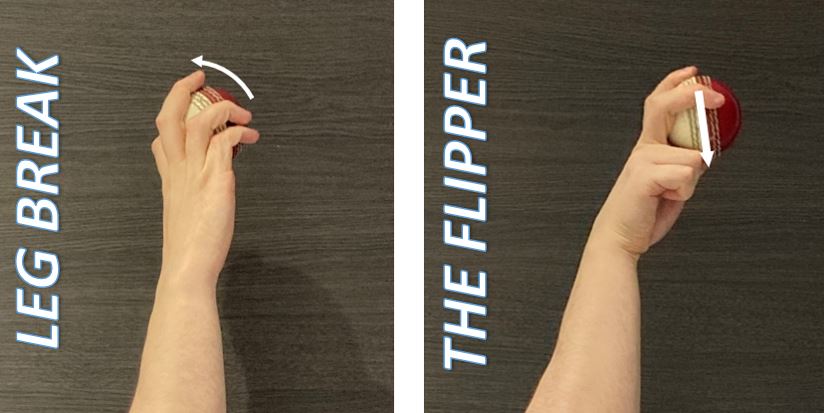
I remember Shane Warne saying that the best way of practicing the flipper is to practice the motion of clicking your fingers, and then including a cricket ball in the process. As you flick the ball from one hand to the other, you should be using the same motion as you would when clicking your fingers. Squeeze your thumb over the top of the ball and push down with your index/middle fingers. Have a look at the photo above if you want a bit more of an idea of what I mean!
The Off Break
The off break is the stock delivery that is used by off spin bowlers like Ravi Ashwin, Ravindra Jadeja and Moeen Ali. For right arm off spin bowlers, the off break will turn from left to right, or in towards the body of a right handed batter. For left arm off spin bowlers, the off break will turn from right to left – away from the body of a right handed batter.
Once again, off spin bowlers should be aiming to land their off breaks on a full length that entices batters into a drive or a defensive stroke. If they can do this they open up many more modes of dismissal for themselves, including edges to the keeper and the slips, inside edges to short leg, LBW and bowled.
If you want to bowl the off break, follow the steps below:
- Again, the first thing to get right with the off break is the grip. If you copy the grip you can see in the picture below – you’ll be fine!
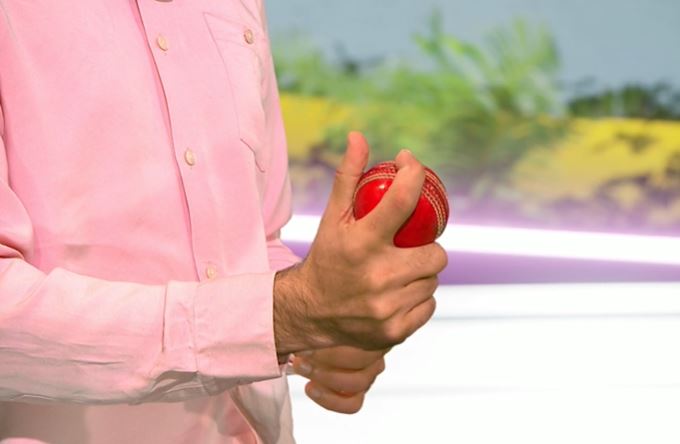
- With the ball gripped properly, the spin bowler should begin their run up and prepare to deliver the ball once they reach the crease.
- As the bowling arm rotates and gets to its highest point, the bowler must ensure that their palm is pointing in a specific direction. This helps to make sure that the spin will be applied in the right direction. Right arm off spin bowlers should be pointing their palm in a north west direction, or towards the number 10/11 if you imagine a clock face. Left arm off spin bowlers should do the opposite, pointing their palm in a north east direction, or in the direction of the numbers 1/2 on an imaginary clock face. The photos below should make this a bit clearer!
- Finally, the bowler must now apply the spin as they release the ball. The index fingers should be ripped over the top of the ball as forcefully as possible. The picture below should help you to see what I mean. Just like the leg break, the more force you apply here, the more aggressively the ball will spin!
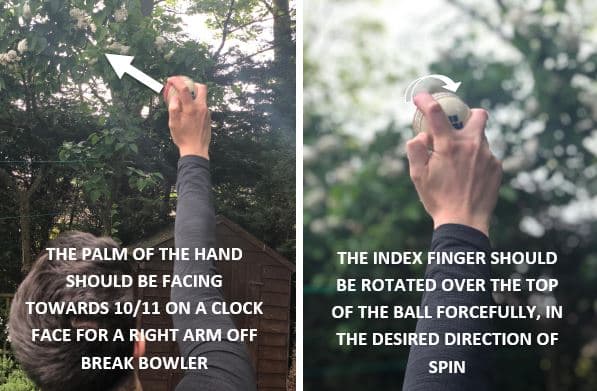
I’ve written a specific post covering everything you need to know about bowling the off break, so if you want to read a more detailed version – click the link here.
Top spinner (Off Spin Bowlers)
The top spinner is the first variation I’m covering here that applies to off spin bowlers. As you’ve probably guessed, it behaves in exactly the same way that the top spinner for leg spin bowlers behaves – it has a tendency to bounce higher than a normal delivery and dip suddenly on the batter whilst in flight.
If you’re an off spin bowler and you want to learn how to bowl the top spin delivery, check out the steps below:
- Hold the ball in the normal off break grip that I’m demonstrating below.
- With the ball gripped properly, the spin bowler should begin their run up and prepare to deliver the ball once they reach the crease.
- As the bowling arm rotates and gets to its highest point, the bowler must ensure that their palm is pointing in a specific direction. This helps to make sure that the spin will be applied in the right direction. Right arm off spin bowlers should twist their arm around so that their palm is pointing towards the west, or towards the number 9 if you imagine a clock face. The thumb-side of your hand should be pointing directly away from the batter as you deliver the ball. Left arm off spin bowlers should do the opposite, pointing their palm towards the east, or in the direction of the number 3 on an imaginary clock face. Again, the thumb-side of the hand should be facing away from the batter. The photo below should make this a bit clearer!
- Finally, the bowler must now apply the spin as they release the ball. The index finger should be rotated forcefully over the top of the ball – applying the over spin.
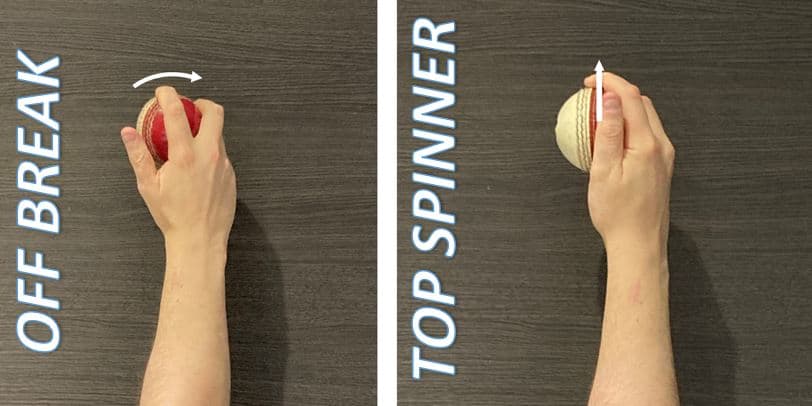
The Arm Ball
The arm ball is another popular variation delivery amongst off spin bowlers, and can be deadly when used correctly. The aim when bowling the arm ball isn’t to spin the ball. Instead, it will travel pretty straight towards the batter and will be bowled at a higher pace than a normal spinning delivery. Additionally – if the arm ball is bowled correctly then the ball can even swing through the air! I think it’s fair to say that the arm ball behaves more like a delivery from a medium pace bowler than one from a spin bowler!
If you want to learn how to bowl this ball, follow the steps below:
- The arm ball requires a slight change of grip from the usual off break. Instead of having your index and middle fingers gripped across the seam like usual, you should turn the ball around so that your index finger now lies alongside the seam like a fast bowler! You can see this in the photo below
- The bowler should go through their normal delivery stride and prepare to deliver the ball like they usually would
- As the bowling arm rotates and the ball is about to be released, the off break bowler will keep their wrist behind the ball and try to push the delivery through like a fast bowler. The seam can be tilted slightly in a direction of the bowler’s choice, and the index finger will be used to apply a backwards rotation to the ball along that axis, just like a fast bowler.
- If bowled correctly, the seam will remain upright as it travels through the air. This means there is more chance of the bowler achieving movement in the air! This makes the ball harder for the batsman to play.
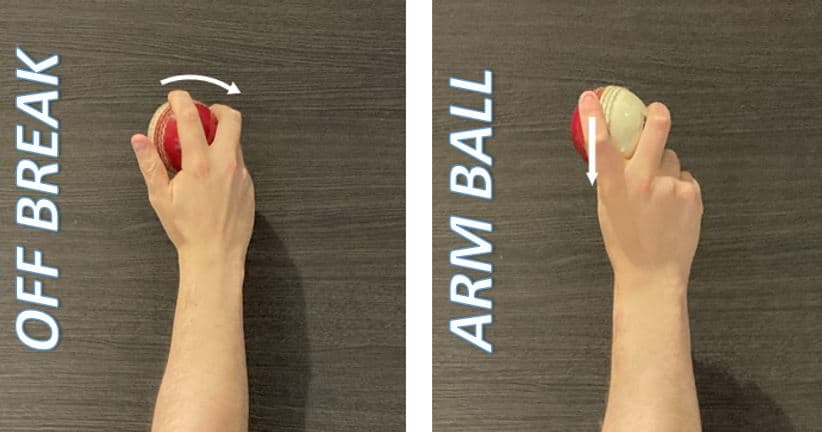
The Doosra
The Doosra is probably the most famous variation bowled by off spin bowlers, but it’s also probably the hardest delivery in the game of cricket to bowl legally. Bowlers are not allowed more than a 15-degree bend in their elbow when delivering the ball, and it just so happens that there are very few off spin bowlers that can deliver the Doosra without bending their arm more than this! This is why you don’t see many people using it in matches.
If a bowler can bowl it, the Doosra is one of the deadliest deliveries in the sport. It spins the opposite way to an off spinner’s normal off break delivery, meaning that for a right arm bowler the Doosra spins from right to left, and for a left arm off spin bowler the Doosra spins from left to right. It is also very difficult for batters to spot! As a result, it can confuse even the greatest players and force them into mistakes.
If you want to know what the Doosra looks like and how to bowl it, take a look at the steps below:
- The grip used for the delivery is exactly the same as the grip used for the normal off break. I’m demonstrating this below!
- The bowler should go through their normal delivery stride and approach the crease as usual, preparing to release the ball.
- As the bowling arm rotates and the ball is about to be released, the bowler should turn their arm so that they are showing part of the back of his hand to the batsman, and cock their wrist slightly (shown in the picture below). Getting the arm and wrist in this position may require the bowler to contort their shoulder a little bit. If the arm is in the right position, then a right arm off spin bowler will have the seam pointing towards first slip, or the number 11 on an imaginary clock face. A left arm off spin bowler will have the seam pointing towards the number 1 on an imaginary clock face
- Keep in mind that having the arm slightly bent during this phase of the delivery definitely makes the Doosra easier to bowl. It is very difficult to propel the ball down the pitch at a good speed in this way when you are bowling with a totally straight arm. Just remember that your arm can’t bend too much, 15 degrees is the maximum!
- From here, the index and middle fingers are used to impart the spin. The middle finger will often start the process of rotation, and then the index finger is used to forcefully flick the ball in the direction of the spin as it rotates over the top.
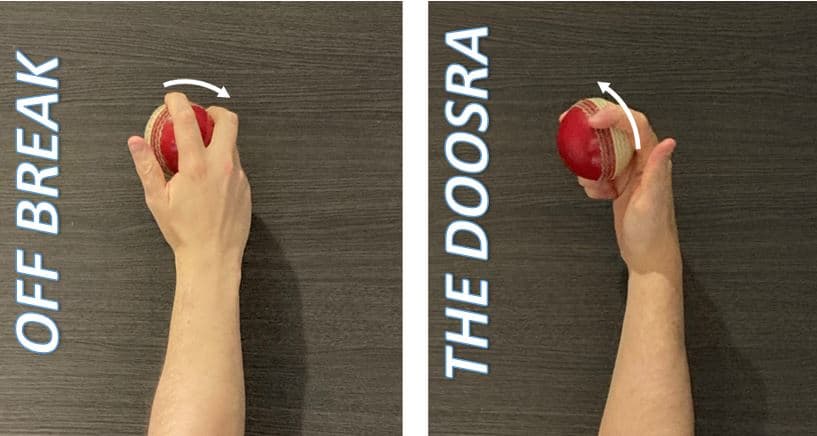
The Carrom Ball
The carrom ball is a unique type of delivery that is often bowled by off spin bowlers as a variation to their normal deliveries. Amongst popular off spin bowlers in modern cricket, 2 of the people you’ll see bowl Carrom balls most regularly are Mujeeb Ur-Rahman and Ravichandran Ashwin.
So, how does the Carrom ball behave? It basically spins in the opposite direction to a normal off spin delivery, but it is bowled out of the front of the hand and requires the bowler to have very strong fingers in order to flick the ball and apply the spin. Let’s have a look at what it takes to bowl it below:
- The grip required for the Carrom ball is different to the one used for most other spin deliveries. The most common grip used to bowl the Carrom ball involves the use of the thumb, the index and the ring finger. The index finger is used to secure the ball at the top, and the thumb and ring finger are used to secure the ball at the bottom. Check the photo below to see this grip!
- The bowler should go through their normal delivery stride and approach the crease as usual, preparing to release the ball.
- As the bowling arm comes over and the ball is about to be released the bowler must extend and straighten their bent ring finger, rolling it up the edge of the ball. At the same time, the bowler will pull down on the opposite side of the ball with their thumb. This action applies the spin to the ball and ‘shoots’ the ball out of the front of the hand. The photo below should make this a bit easier to visualise!
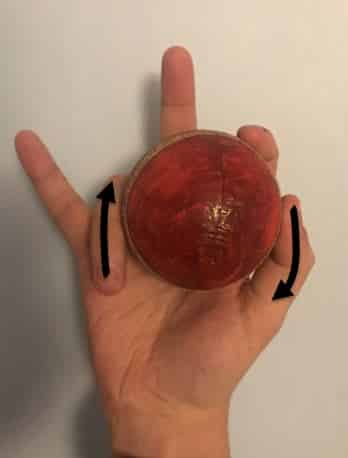
The Under Cutter
The under cutter is the final main type of delivery that I’m going to cover in this post – and it’s a good place to finish! The under cutter is basically an off spin bowler’s version of the slider. From the perspective of the batsman, the under cutter looks incredibly similar to the standard off break – so it’s incredibly hard for them to pick up and spot out of the hand. The intention when bowling this ball is to get it to ‘slide’ on towards the batter and not spin at all. If the batsman does not pick the delivery, they could end up being bowled or getting out LBW when the ball fails to spin.
The steps below will teach you how to bowl the under cutter:
- The grip used for the under cutter is exactly the same as the one required for the standard off break. You can see me demonstrating this below!
- With the ball in the correct grip, the bowler can begin their run up. They should approach the crease exactly as normal and prepare to release the ball.
- As the bowling arm rotates and the ball is about to be released, the first thing the bowler must do is point their palm directly towards the batter. This applies to both right arm and left arm off spin bowlers. The second thing they need to do is tilt their hand backwards slightly, as I’m demonstrating in the picture below. The ball is now ready for release!
- As the ball leaves the hand, the bowler should drag the index finger over the top of the ball – thus applying the spin! Because of the direction that the palm is facing, any spin that is applied will be side spin – which can naturally lead to the ball sliding on towards the batter.
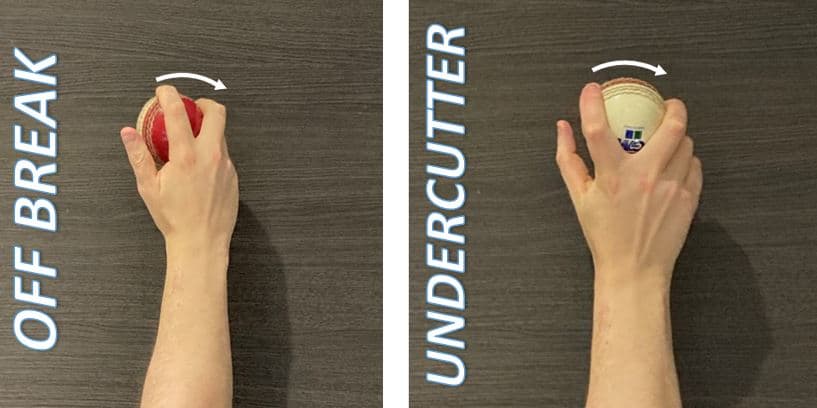
As I mentioned before when covering the slider, the bowler can choose to turn their arm around a little more if they want to make absolutely sure that the ball slides on towards the batter without spinning. A right arm off spin bowler may wish to point their palm in a north east direction (towards 1/2 on an imaginary clock face), whereas a left arm off spin bowler may want to point their palm towards the north west direction (towards 10/11 on an imaginary clock face). This isn’t completely necessary, but it allows you to get more under cut on the ball which should stop it deviating laterally once it hits the pitch!
Other Deliveries
The two deliveries below can be bowled by any type of bowler – they aren’t really specific to fast bowling or spin bowling
Full Toss
A full toss is a delivery that fails to bounce before it reaches the batter. You see a lot of these types of deliveries bowled, especially in limited overs cricket where fast bowlers are trying to bowl yorkers. When bowling a yorker it’s incredibly easy to bowl the ball slightly fuller and bowl a full toss!
Sometimes, full tosses can be easier for a batter to time and they can strike them to the boundary with incredible ease. However, sometimes a full toss will take a batter by surprise, and they will mistime the ball completely.
Personally, I would advise against trying to bowl full tosses. There are many other types of deliveries that I’ve covered here that are much more effective than a full toss, so if I were you I’d devote my time to practicing and developing those!
Beamer
A beamer is very similar to a full toss. Both of these deliveries are ones which fail to bounce before they reach the batter, however, there is one key difference! The beamer will not bounce before it reaches the batter, but it will also be aimed at their upper body or their head – making it much more of a dangerous delivery.
This type of delivery is so dangerous that it will be automatically ruled by the umpire as a no ball. It is written in the cricket rules that any full toss that is above waist height as it passes the batter (a beamer) should be given as a no ball. So, every time you bowl one of these, you’ll be giving one run away and having to bowl an extra ball. Plus, in short form cricket like T20’s, bowling a beamer will result in a free hit for the batting side. This is definitely something that all bowlers should be trying to avoid.
As I’m sure you’ve gathered by now, a beamer is not a delivery that you should be trying to bowl, so I won’t be teaching you how to bowl it! I much prefer to use a well targeted bouncer to intimidate a batter rather than resorting to illegal tactics!
Conclusion
Now that was a long post! If you made it through to the end – thank you so much for reading – I truly appreciate it and I hope you found it informative.
To close this post out, it’s important to note that some of the deliveries I’ve mentioned above can be combined. For example, a fast bowler can bowl a split finger delivery that is also a yorker. A spin bowler could potentially bowl an arm ball that is also a full toss! However, each of the deliveries I’ve explained have their own characteristics that make them unique.
As a final point, I’ll say that there may be a few more obscure deliveries that people may think I’ve missed. However, I think I’ve done an excellent job of covering all the main ones that are widely used across the sport. If any new deliveries emerge in the next few years and become popular among bowlers, I’ll be sure to add them to this list!
